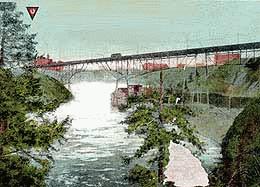On June 27, 1892, Spokane's second Monroe Street Bridge, a steel bridge, is completed. It replaces a rickety wooden bridge that burned down in 1890. The steel Monroe Street Bridge will be replaced in 1909 with Spokane's historic concrete arch Monroe Street Bridge, at the time the largest concrete-arch bridge in the world.
The new steel bridge accommodated power wires for streetcars and overhead lighting. This bridge vibrated badly, and in 1905 a National Good Roads Association consultant declared it unsafe, although it continued to be used. Even Ringling Brothers Circus elephants were said to have balked at crossing it. The second Monroe Street Bridge was in use for barely 20 years.

